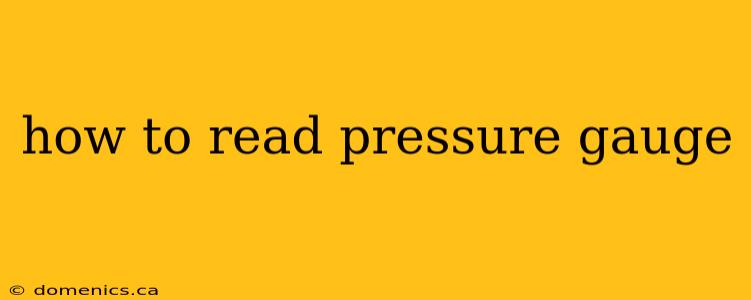Pressure gauges are essential tools in various industries, from plumbing and automotive repair to industrial processes and HVAC systems. Understanding how to accurately read a pressure gauge is crucial for safety and effective operation. This comprehensive guide will walk you through the process, covering different gauge types and potential issues.
Understanding Pressure Gauge Types
Before diving into reading, let's clarify the different types of pressure gauges:
-
Bourdon Tube Gauges: These are the most common type, using a C-shaped tube that straightens when pressure is applied. The movement is mechanically linked to a needle indicating pressure.
-
Diaphragm Gauges: These use a flexible diaphragm that deflects under pressure. They're often used for low-pressure applications and corrosive fluids.
-
Digital Gauges: These use electronic sensors to measure pressure and display the reading digitally. They often provide greater accuracy and easier reading.
-
Compound Gauges: These gauges display both positive and negative pressure.
How to Read a Pressure Gauge: A Step-by-Step Guide
Reading a pressure gauge involves several simple steps:
1. Identify the Units: The first step is to identify the units of measurement used on the gauge. Common units include pounds per square inch (psi), kilopascals (kPa), bars, and millimeters of mercury (mmHg). Make sure you understand the scale before attempting to take a reading.
2. Note the Gauge Range: Pressure gauges have a maximum and minimum reading. Knowing the range is essential for interpreting the pressure reading accurately. A gauge with a range of 0-100 psi will give you a different interpretation than one with a range of 0-1000 psi.
3. Locate the Needle: The needle is the indicator pointing to the current pressure reading. Make sure the needle is not stuck or damaged before recording the reading.
4. Read the Scale: Look at the gauge's markings and determine the intervals between them. Each interval represents a specific pressure increment. Many gauges use clearly marked increments; however, some may require more careful examination.
5. Determine the Pressure: Look at where the needle sits on the scale. Read the value on the scale directly corresponding to the needle's position. For example, if the needle points midway between 20 and 30 psi, the pressure is approximately 25 psi.
6. Account for Gauge Accuracy: Every pressure gauge has a tolerance, representing a range of error. Check the gauge's specifications for this information. It's important to account for this tolerance when recording your reading, especially in situations where high accuracy is critical.
7. Consider Environmental Factors: Extreme temperatures or vibrations can affect gauge accuracy. If possible, make readings in stable environmental conditions.
Troubleshooting Common Issues
-
Stuck Needle: If the needle is stuck, gently tap the gauge. If this doesn't resolve the issue, the gauge may be faulty and should be replaced.
-
Inaccurate Readings: If you suspect an inaccurate reading, compare readings with another gauge if possible. Ensure the gauge is correctly installed and that no obstructions are affecting its operation.
-
Damaged Gauge: A cracked gauge face, bent needle, or damaged connection should be immediately replaced.
FAQs: Understanding Pressure Gauge Readings
Q: What does psi mean?
A: Psi stands for pounds per square inch, a common unit of pressure.
Q: How often should I check my pressure gauge for accuracy?
A: The frequency depends on the application. For critical applications, regular calibration is recommended. In less critical applications, visual inspections can be sufficient to identify damage. If in doubt, consult the gauge's manufacturer guidelines.
Q: My gauge shows a negative pressure. What does that mean?
A: Negative pressure (vacuum) indicates a pressure lower than atmospheric pressure. This is common in some systems.
Conclusion: Mastering Pressure Gauge Reading
Accurately reading a pressure gauge is a critical skill in many fields. By understanding the different types of gauges, following the steps outlined above, and being aware of potential issues, you can ensure accurate pressure readings for safer and more efficient operation. Remember to always prioritize safety and replace damaged or suspect gauges promptly. Regular calibration and maintenance of your pressure gauges will improve accuracy and extend their service life.
